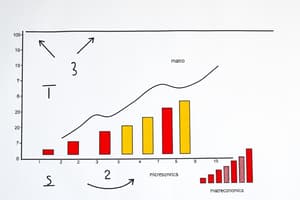Podcast
Questions and Answers
What is the primary focus of microeconomics?
What is the primary focus of microeconomics?
- The economy as a whole
- Individual consumers and businesses (correct)
- Government spending and taxation
- Market structures and competition
What is opportunity cost?
What is opportunity cost?
- The total value of all goods produced
- The benefit lost from a market failure
- The cost of choosing one option over another (correct)
- The profit gained from a decision
Which market structure is characterized by a single firm controlling the market?
Which market structure is characterized by a single firm controlling the market?
- Monopoly (correct)
- Monopolistic competition
- Perfect competition
- Oligopoly
Which of the following best describes fiscal policy?
Which of the following best describes fiscal policy?
What does the unemployment rate measure?
What does the unemployment rate measure?
Which of the following economic theories emphasizes free markets?
Which of the following economic theories emphasizes free markets?
How does monetary policy influence the economy?
How does monetary policy influence the economy?
What is the effect of inflation on the economy?
What is the effect of inflation on the economy?
Flashcards are hidden until you start studying
Study Notes
Key Concepts in Economics
-
Definition: Economics is the study of how individuals and societies allocate scarce resources to satisfy unlimited wants.
-
Branches of Economics:
- Microeconomics: Focuses on individual consumers and businesses, analyzing market behavior and decision-making.
- Macroeconomics: Examines the economy as a whole, including topics like inflation, unemployment, and national income.
-
Basic Economic Principles:
- Scarcity: Limited resources versus unlimited wants leads to the need for choices.
- Opportunity Cost: The value of the next best alternative forgone when making a decision.
- Supply and Demand: Prices are determined by the relationship between the quantity of goods available and the desire for them.
-
Market Structures:
- Perfect Competition: Many firms, identical products, easy entry and exit; firms are price takers.
- Monopolistic Competition: Many firms, differentiated products, some control over price.
- Oligopoly: Few firms dominate the market; can lead to collusion.
- Monopoly: Single firm controls the entire market; significant price-setting power.
-
Economic Indicators:
- Gross Domestic Product (GDP): Total value of all goods and services produced in a country.
- Unemployment Rate: Percentage of the labor force that is unemployed and actively seeking work.
- Inflation Rate: Rate at which the general level of prices for goods and services is rising.
-
Fiscal Policy:
- Government adjustments in spending and taxation to influence the economy.
- Aimed at promoting economic growth, reducing unemployment, and controlling inflation.
-
Monetary Policy:
- Conducted by a country's central bank to manage money supply and interest rates.
- Tools include open market operations, discount rate adjustments, and reserve requirements.
-
International Economics:
- Trade: The exchange of goods and services across borders; benefits include comparative advantage and specialization.
- Exchange Rates: The value of one currency for the purpose of conversion to another; influences trade balance.
-
Economic Theories:
- Classical Economics: Emphasizes free markets, self-regulating behavior, and minimal government intervention.
- Keynesian Economics: Advocates active government involvement to manage economic cycles and stimulate demand.
-
Behavioral Economics:
- Studies how psychological factors and biases impact economic decision-making.
-
Development Economics:
- Focuses on improving the economic conditions of developing countries through policies aimed at enhancing growth and reducing poverty.
Important Economic Models
- Circular Flow Model: Illustrates how money flows between households and firms in an economy.
- Production Possibility Frontier (PPF): Shows the maximum attainable combinations of two goods that can be produced with available resources.
Conclusion
Understanding economics involves analyzing various factors that influence decision-making and the allocation of resources, both on a micro and macro scale. Key principles, indicators, and models help to clarify economic behavior and policy impacts.
Definition and Overview
- Economics studies the allocation of scarce resources to meet unlimited wants.
Branches of Economics
- Microeconomics: Analyzes individual consumers and businesses, focusing on market behavior and decision-making processes.
- Macroeconomics: Investigates the economy as a whole, addressing issues such as inflation, unemployment, and overall national income.
Basic Economic Principles
- Scarcity: A fundamental concept stating that limited resources compel choices among competing wants.
- Opportunity Cost: Represents the value of the next best alternative sacrificed when making a choice.
- Supply and Demand: Dictates that prices are influenced by the quantity of goods available against consumer demand.
Market Structures
- Perfect Competition: Characterized by numerous firms selling identical products with no control over prices.
- Monopolistic Competition: Features many firms offering differentiated products, allowing some price control.
- Oligopoly: A market dominated by a few firms; potential for collusion exists.
- Monopoly: Exists when a single firm has complete market control, enabling significant price-setting power.
Economic Indicators
- Gross Domestic Product (GDP): The total monetary value of all goods and services produced within a nation.
- Unemployment Rate: Measures the percentage of the labor force that is jobless and actively seeking employment.
- Inflation Rate: Indicates the pace at which the general price level of goods and services increases over time.
Fiscal Policy
- Involves government actions related to spending and taxation aimed at influencing economic performance, promoting growth, reducing unemployment, and controlling inflation.
Monetary Policy
- Implemented by central banks to regulate money supply and interest rates using tools like open market operations, discount rates, and reserve requirements.
International Economics
- Trade: The cross-border exchange of goods and services, promoting comparative advantages and specialization.
- Exchange Rates: The value conversion between currencies, impacting trade balances.
Economic Theories
- Classical Economics: Advocates for free-market principles and minimal government intervention.
- Keynesian Economics: Suggests that proactive government measures are essential for managing economic fluctuations and boosting demand.
- Behavioral Economics: Explores how psychological factors and cognitive biases shape economic choices.
- Development Economics: Aims to improve living conditions in developing countries through targeted growth policies and poverty alleviation strategies.
Important Economic Models
- Circular Flow Model: Demonstrates the movement of money between households and firms within the economy.
- Production Possibility Frontier (PPF): Illustrates the maximum feasible combinations of two products that can be produced with given resources.
Conclusion
- Mastery of economics requires analyzing influential factors and decision-making processes on both micro and macro levels, employing key principles, indicators, and models to better understand economic behavior and policy effects.
Studying That Suits You
Use AI to generate personalized quizzes and flashcards to suit your learning preferences.




